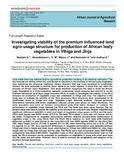| dc.description.abstract | Land subdivision has reduced land for agricultural production resulting in its intensive cultivation. This has lowered soil fertility which has contributed to reduction in the diversity of African Leafy Vegetables thus restricting the otherwise traditional dietary diversity that was once beneficial to smallholder farmers. As land continues to decline, there needs to be some impetus in place that can retain the diversity of African Leafy Vegetables. This study therefore recognized the need to niche the African Leafy Vegetables to a none-competing, specially constructed raised cropping bed referred to us the Premium Influenced Land Agro-usage structure (PILA). A study to investigate the viability of the PILA structure for production of vegetable crops was undertaken in Vihiga and Jinja. The objective of the study was to evaluate the benefits of the PILA structures. PILA structures were constructed on 20 smallholder farms in Vihiga and Jinja. Vegetable crops Solanum scabrum, Cleome gynandra, Amaranthus hybridus) and exotic vegetables (Daucas carota) were grown on these structures. The same procedure was done on farmers’ conventional plots (Flat beds). Analysis to compare the performance of vegetable crops between the PILA and Flat beds was done using Genstat. The net present value was used to assess the viability of the structure for long term use. Results indicated high significant differences (p≤0.001) in yield and height of vegetables crops grown on PILA and flat beds, (PILA yield (kg/ha) was 42254 versus 27772 for flat beds, PILA height in (cm) was 14.8 versus 10.8 for flat beds). Comparisons in vegetable performance between seasons showed better performance of vegetable crops in the Long Rains than the Short Rains seasons for both sites with significant difference (p=0.001) in yield (kg/ha) for the Long Rain (LR) was 36064 against 33962 for the Short Rain (SR), mean height (cm) for LR was 13 against 12.5 for SR, mean branching (score out of 3) for LR was 2.5 against 2.4 for SR. Also significant differences in vegetable performance were detected between Vihiga and Jinja in height and yield; mean yield (kg/ha) for Vihiga was 34962 and 36064 for Jinja, mean height (cm) for Vihiga was 12.8 and 16.6 for Jinja. The PILAs had a high net present value (KSH191390) compared to flats beds (KSH122087). Vegetable crops on PILA structure performed better than on Flat beds, the PILA structure can be promoted for production of vegetables in areas with small land sizes like the urban and peri-urban. However, there is need to increase the acceptability and adoption of the structure through awareness. | en_US |

